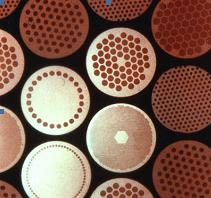Taking a closer look at LHC
The phenomenon of superconductivity was first observed in 1912 in the laboratory of Heike Kamerlingh Onnes, at the University of Leiden (Holland). At low temperatures certain materials (about 800 superconducting compounds have been tabulated up to date) suddenly lose their resistance to the flow of electricity on cooling. The phenomenon remained a laboratory curiosity until 1954 when G. B. Yntema at the University of Illinois, made the first successful superconducting magnet. The slow progress can be partially attributed to the difficulty in obtaining the extremely low temperatures required, and the lack of understanding of how to create electrically and thermally stable wires from superconductors. But the primary limitation was that the superconducting phenomenon was not only limited to low temperatures but also to a restricted range of electrical current density and magnetic field and that the range of these properties was particularly limited in early superconductors.
The next figure shows the dependence between the magnetic field and the temperature (Hc and Tc are specific for each material):
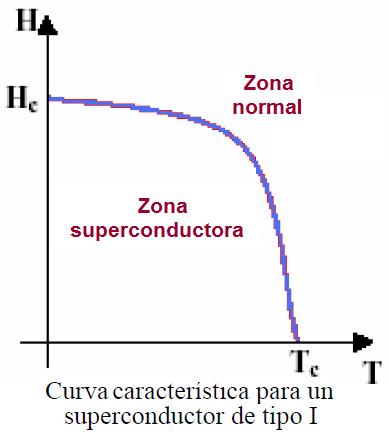
The early superconductors, such as Pb, In and Hg are classified as Type I superconductors, these are superconductors in which magnetic flux is excluded (Meissner Effect) from their bulk and the critical current density is limited to a surface layer of approximately one tenth of a micron.
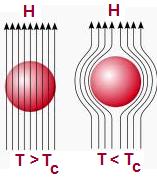
Meissner Effect
The maximum fields in which these superconductors can operate are usually less that 0.1 T (similar to the flux-density between the poles of a horse-shoe permanent magnet). These limitations make Type I superconductors impractical for wire and cable applications.
All "technical superconductors," that is superconductors that can be readily fabricated into wires and cables for high current applications, are Type II superconductors. In Type II superconductors, if Hc1<H<Hc12 magnetic flux penetrates the bulk of the superconductor to form individual flux quanta, and they can be used for applications with high magnetic fields and high currents.
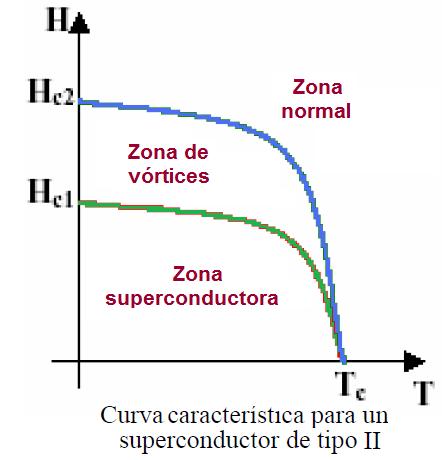
Type-II superconductors are usually made of metal alloys or complex oxide ceramics, Niobium, Vanadium, Technetium, Diamond and Silicon are pure element Type-II superconductors. Metal alloy superconductors also exhibit Type-II behavior (e.g. niobium-titanium, niobium-tin). In practice, the ductil alloy niobium-titanium (Nb-Ti, 47wt%) and the intermetallic compound Nb3Sn are currently the only materials used for magnet.
The 1700 large magnets and the 8000 corrector magnets of the LHC are wound with Nb-Ti.
Other Type-II examples are the cuprate-perovskite ceramic materials which have achieved the highest temperatures to reach the superconducting state. These include compounds of LaBaCuO and YBaCuO, which is famous as the first material to achieve superconductivity above the boiling point of liquid nitrogen. One of the main problems with these materials is that they are brittle due to their ceramic nature.
Magnesium diboride, discovered in 2001, and the family of the ferro-oxypnictides, discovered in 2008, are the most promising for applications.
|
A it has been said before, the maximum values of temperature, electrical current and magnetic field are interdependent and when plotted in 3 axes form a "critical surface". Picture shows the critical surface for a Type II superconductor, which is the boundary between superconductivity and normal resistivity in 3 dimensional space. The applied field (B), the temperature (T) and the current density (J) must be maintained below the critical surface in order to retain superconductivity. |
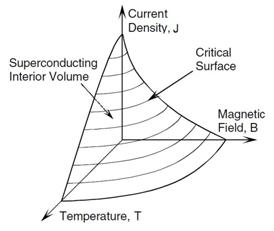 |
In the most widely used technical superconductors, Nb-Ti and Nb3Sn, the upper critical fieldsare 13 T and 27 T respectively and current densities > 105 A/cm² can be carried (compared to ~ 103 A/cm² for domestic Cu wire).
The critical temperatures for Nb-Ti and Nb3Sn are 10 K and 18 K respectively. Liquid Heprovides cooling to 4.2 K at atmospheric pressure and as low as 1.8 K at reduced pressure.
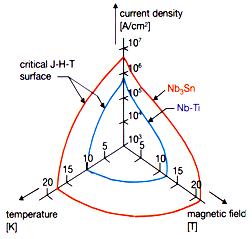
(Taken from Lyndon Evans (2009). THE LARGE HADRON COLLIDER: A MARVEL OF TECHNOLOGY. CERN AND EPFL PRESS)
Superconductors must be formed into composite wires in order for them to be used in high current applications and these wires may also be cabled.
| Superconducting wire is almost always of a multifilamentary design in which individual continuous filaments (< 30 μm in diameter) are embedded in a high conductivity matrix. When conditions in a localized region of a superconductor exceed the critical surface, that area will start to conduct resistively producing local heating. The resulting heat and current transfer will start a cascade effect and result in a rapid transition of the whole superconductor to the normal state (quenching).
Indeed, the ability to transfer heat and current away from localized regions by subdividing the filaments into a high conductivity matrix was a key step towards producing practical superconductors |
Image taken from Wilson M. (2006). LECTURE. SUPERCONDUCTING ACCELERATORS. Cockroft Institute (www.cockcroft.ac.uk) |
The most common design for Nb-Ti magnets is the Rutherford cable, which consists of a fully transposed, flat cable. Using this approach, high aspect ratio cables can be produced with as many as 46 strands. For electromagnetic reasons, the composite wires are twisted so that the filaments look like a rope.
More information in:
Rossi L. (2010). SUPERCONDUCTIVITY: ITS ROLE, ITS SUCCESS AND ITS SETBACKS IN THE LARGE HADRON COLLIDER OF CERN. Supercond. Sci. Technol. 23 (2010) 034001 (17pp).
Lee Peter J. (2002). SUPERCONDUCTOR: WIRES AND CABLES: MATERIALS AND PROCESSES. The Applied Superconductivity Center, The University of Wisconsin-Madison.
|
AUTHORS Xabier Cid Vidal, PhD in experimental Particle Physics for Santiago University (USC). Research Fellow in experimental Particle Physics at CERN from January 2013 to Decembre 2015. He was until 2022 linked to the Department of Particle Physics of the USC as a "Juan de La Cierva", "Ramon y Cajal" fellow (Spanish Postdoctoral Senior Grants), and Associate Professor. Since 2023 is Senior Lecturer in that Department.(ORCID). Ramon Cid Manzano, until his retirement in 2020 was secondary school Physics Teacher at IES de SAR (Santiago - Spain), and part-time Lecturer (Profesor Asociado) in Faculty of Education at the University of Santiago (Spain). He has a Degree in Physics and a Degree in Chemistry, and he is PhD for Santiago University (USC) (ORCID). |
CERN CERN Experimental Physics Department CERN and the Environment |
LHC |
IMPORTANT NOTICE
For the bibliography used when writing this Section please go to the References Section
© Xabier Cid Vidal & Ramon Cid - rcid@lhc-closer.es | SANTIAGO (SPAIN) |




